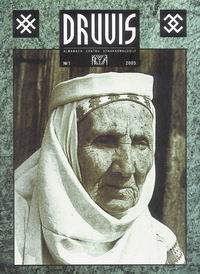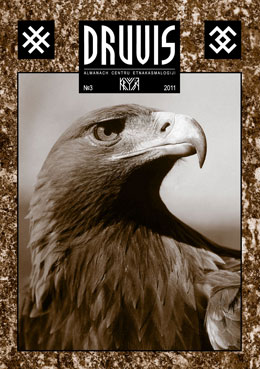 Stowarzyszenie na rzecz Tradycji i Kultury „Niklot”
Stowarzyszenie na rzecz Tradycji i Kultury „Niklot”
zaprasza na spotkanie:
Ruch rodzimowierczy (neopogański)na Białorusi współczesnej. Idee, organizacje, kultura
Prelegent: mgr Iwan Łysiuk (wspólpracownik pisma „Druvis”, Mińsk).
Spotkanie odbędzie się 7 listopada (pon) od godz. 18.00
w lokalu Stowarzyszenia Wolnego Słowa
ul. Marszałkowska 7 (wejście od ul. E. Zoli).
Fragment ze strony Druvis – kto może (to znaczy rozumie) powinien ją odwiedzać
DRUVIS — Summary
http://kryuja.org/artykuly/druvis/druvis_english_summary.html
Almanac «Druvis» is founded and issued by the Centre of Ethnocosmology «Kryŭja». The articles on cultural studies, ethnocosmology, ethnography, history, geopolitics, philosophy, political science and other disciplines are published in this magazine. All of them are the result of research of the Centre’s contributors as well as other Belarusian and foreign authors. The almanac is dedicated to the problems of national and ethnic identity of the Belarusians. Special attention in the texts is given to the Baltic element which played a vital part in the ethnogenesis of the Belarusians.
The introductory article «Editorium» tells about the almanac and the circumstances of its appearance; the title «Druvis» and the subject of the first issue are explained. The metapolitical strategy is defined as one of ways of preserving originality in the world where the war of cultures takes place and the destructive universalistic and egalitarian tendencies are at apogee. It is accentuated that Belarusian culture as well as Lithuanian, Lettish and others is one of the integral parts of the whole Baltic cultural field, which in turn is an important structural unit of Indo-European world. The essential problem in preserving, studying and using the achievements of traditional culture is to actualize its formerly defining element, which is the ancient religion of the Balts, local forms of polytheism, paganism. That accounts for the choice of the almanac’s title. The word druvis (druwis) derives from Prussian language where it was used as equivalent to Latin notion credo and German der Glaube in the sense of religious faith and the Creed. This word is to become equal to such terms as paganism, heathenism (bel. paganstva, jazyčnictva) which have negative shades of meaning. Analysis of pre-Christian (pagan) cultural heritage is important for the right understanding of contemporary problems concerning formation of national and ethnic identity of the Belarusians. In Europe the Belarusians, Lithuanians and Letts are known to be the peoples, who managed to preserve their traditional,pre-Christian in its essence culture best of all. The first issue of almanac «Druvis» is dedicated to the land of Crivia (Kryvija) that took a special place in the Baltic world and nowadays forms a great part of Belarus. It is the very place where the foundation of future Belarusian ethnos was laid. Crivia is a peculiar archetype of ethnocultural essence of the Belarusians, and the revival of it is a necessary condition for national renaissance.
- Siarhiej Sańko in the article «Imiony baćkaŭščyny. Kryŭja» («Names of Fatherland. Kryŭja») explores the origin of the ethnochoronym Crivia. It is noted that in many European countries only their names keep reference to the tribes which inhabited their territories in ancient times (e. g. Britons — Britain, Prussians — Prussia). Belarusians are the descendants of the local population, Baltic by origin. However the name itself does not contain any marks of it. The author analyses the ancient name of the land Crivia which has Baltic origin, gives data of antiquity, draws Indo-European linguistic and mythological parallels (Indian, Iranian) which show that Crivia was the country with highly developed heathen culture. It is emphasized that the appellation Crivia derives from the stem *kriv-, which has kept its sacral meaning in Baltic languages up to now; adduced are new arguments in favor of existing connection between the name Crivia and the title of the Balts’ high priest Krivis. It is suggested that the ethnonym Crivitians (bel. kryvičy) is connected with an earlier form *kriev- (*kreiv-) which has not been preserved, but reconstructed (compare Lettish appellation Krievija ‘Russia’ <‘eastern neighbours’> ‘Crivitians’); that form defined the name of population of the Baltic Dniapro-Dźvina (Dniepr-Daugava) culture of Iron Age, separated from a group of tribes of Corded ware culture (id. Battle axe culture) about 4 thousand years ago. The latter is associated to be the ancestors of northern Indo-European peoples. On the examples of toponymy, anthroponymy the sacred status of the land Crivia is traced in Belarus as well as of the caste of priests, that had authority not only with the inhabitants of Crivia, but also with the whole Baltic region. On this ground the hypothesis is put forward about the possible identification of ancient data on the semi-legendary land Hyperborea with the facts of local ethnocultural tradition. New materials are published which make it possible to include Belarus in the range of Baltic cultures, emphasizing the connection of Belarusian and other Baltic peoples’ traditions.
- Alaksiej Dziermant in the article «Kryvičy. Histaryčna-etnagenetyčny narys» («The Crivitians. Historical and Ethnogenetic Study») sums up more than hundred-year-old explorations of archaeologists, anthropologists, linguists, ethnographers, mythologists of the Crivitians — the tribe known from Old Ruthenian chronicles, which inhabited the north-eastern Belarus (Viciebsk, partly Minsk (Miensk) and Mahiloŭ regions of the Republic of Belarus, Smolensk and parts of Tver, Pskov regions of the Russian Federation). The author of the article proves that Crivitians are the successors of the Iron Age cultures, Baltic by origin:Dniapro-Dźvina, Long Barrows. Their culture had a distinctive character in Old Ruthenian time which was close to the one of the neighboring Baltic tribes that was reflected both in material and spiritual spheres. Emphasized are Crivitian and Latgalian relations, as well as common origin of these two Baltic ethnic groups. It is supposed that Crivitians did not come to their territory from other lands, but they were autochthons that is showed by anthropological data, proving that this tribe was close to the Baltic groups according to craniological materials, not to the Slavonic ones. The article contains the facts that make it doubtful, whether the «mass Slavonic migration» to the north of Belarus — the place of living of the Crivitians — really took place at the end of the 1st — beginning of the 2nd millenniums, as many researchers still assert. The brief essay on political history of the Połack land provides the facts that are the evidence of most likely agreed, competitive, rarely hostile relations between Crivitian and Lithuanian princes. It is maintained that the entry of Połack into the sphere of influence of Lithuania and afterwards to the structure of medieval Lithuanian state — on autonomous basis at the beginning — was caused not only by the Lithuanian expansion on West-Ruthenian lands. The author accentuates the uniting initiatives of Lithuania that strived to join around all the former Baltic lands of Old Ruthenia, in particular West Ruthenia (Belarus), including its sizeable part — Crivia, the land of Crivitians. He also supposes that at present the accumulated material of various sciences makes it possible to renounce the customary description of Crivitians as an East-Slavonic tribe. It is suggested that Crivitians as one of the basicsub-ethnic groups in formation of Belarusian nationality should be considered a part of the Baltic ethnic community, which was early influenced by the East-Christian (Orthodox) culture and as a result slavonized.
- Todar Kaškurevič in the article «Kasmagrafija i tapagrafija ŭ kryŭskich legendach pra kamiani-kraŭcy dy pra pachodžańnie rek Vialla (Neris) i Biarezina» («Cosmology and Topography in the Crivian Legends about Stones-Tailors and the Origin of Rivers Vialla (Neris) and Biarezina») considers the sacral meaning of stones in Belarusian tradition. Analysed are mythological conceptions of the Belarusians concerning two main rivers on the Belarusian-Lithuanian land, namely Vialla (Neris) and Biarezina. The author shows that these rivers originate in the place which was formerly sacred for the population of the whole Baltic region and considers the connection between the sources of the rivers and other sacral objects known as stones-tailors (kamiani-kraŭcy), the legends about which contain archaic mythological notions.
- Alaksiej Dziermant in the article «Akoŭski les» («Akoŭski Forest») examines the name of that natural and geographical object of ancient Crivia, which is situated near the sources of the largest East-European rivers: Dźvina (Daugava), Dniapro (Dniepr) and Volga. It is mentioned that this territory is the border of Belarusian ethnographic region (according to the data for the beginning of the 20th century) and the area of settlement of the Baltic-speaking tribes in antiquity. Different etymologies of the appellation Akoŭski (Okovskij) forest are considered, and preference is given to the Baltic version, associating this name with the Baltic (Lithuanian) notion alka that means sacred area, a place used for sacrificing in heathen times. Topography and history of Akoŭski forest make it possible to accept that hypothesis as well as the version, connecting this name with the stem *ak- that points out the relation of the forest’s name to some common source, from which three above-mentioned rivers originated. In support of the both versions the author gives the opinions of authoritative scientists, draws typological and other parallels in Indo-European traditions and languages.



